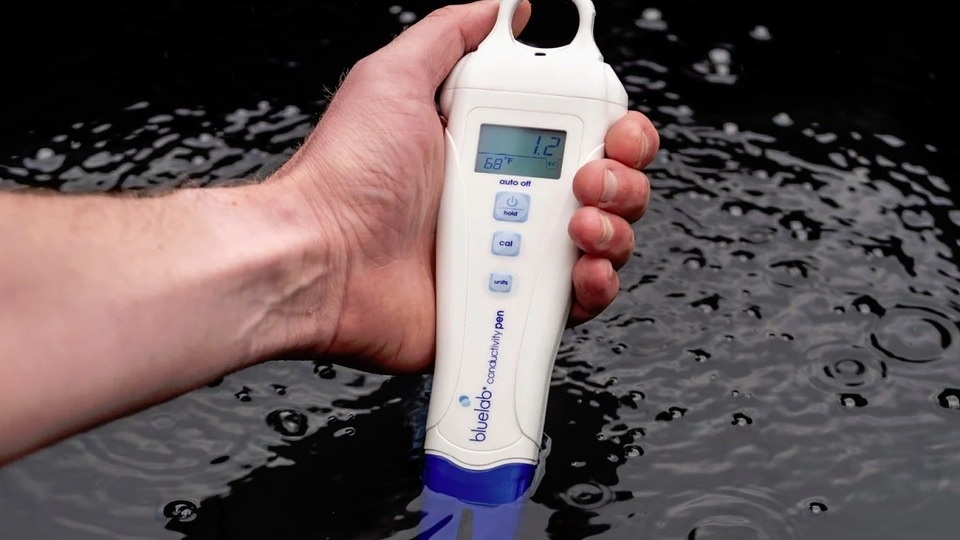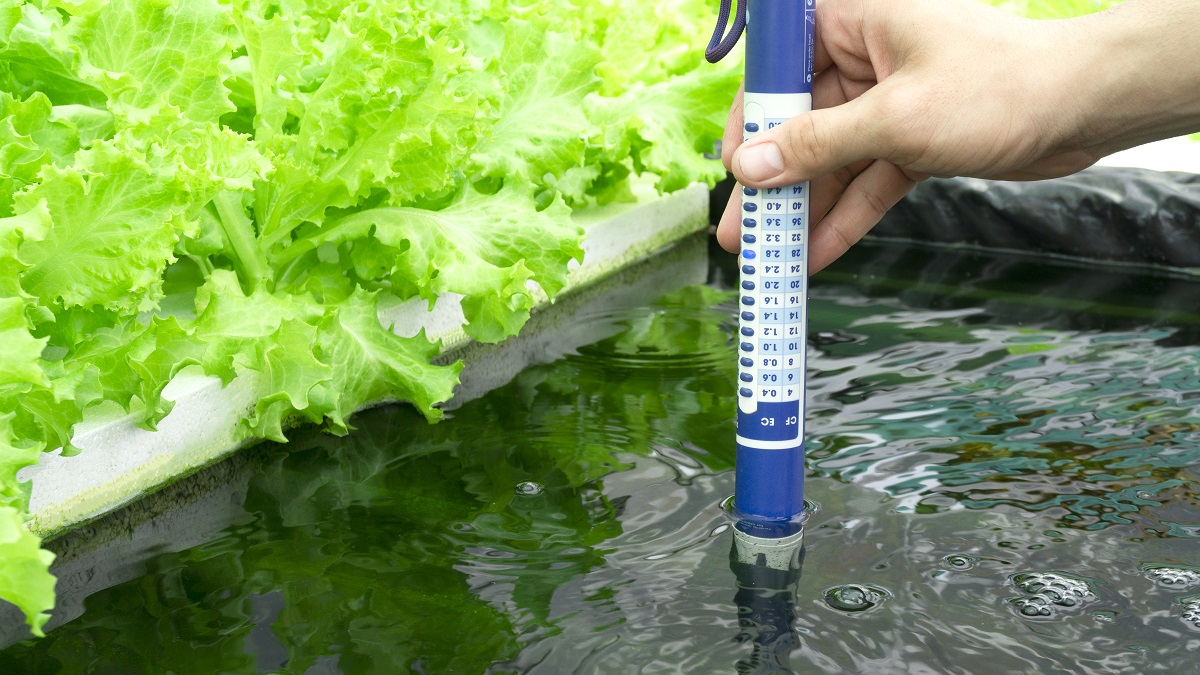- Call an expert today! 0208 808 4321
 Store Locator
Store Locator
pH, EC & PPM Guide for Hydroponics
N.B - The figures below are general guidelines. Matters of pH and EC can be affected by growing conditions and climate, they are variable. It is important to keep both under regular surveillance with appropriate measuring tools.
|
Plant |
pH |
EC (mS/cm) |
PPM |
|
African Violets |
6.0-7.0 |
1.2-1.5 |
840-1050 |
|
Anise |
5.8-6.4 |
0.9-1.4 |
|
|
Anthurium |
5.0-6.0 |
1.6-2.0 |
1120-1400 |
|
Antirrhinim |
6.5 |
1.6-2.0 |
1120-1400 |
|
Aphelandra |
5.0-6.0 |
1.8-2.4 |
1260-1680 |
|
Artichoke |
6.5-7.5 |
0.8-1.8 |
400-900 |
|
Arugula |
5.5-6.8 |
0.8-1.4 |
560-980 |
|
Asparagus |
6.0-6.8 |
1.4-1.8 |
700-900 |
|
Aster |
6.0-6.5 |
1.8-2.4 |
1260-1680 |
|
Aubergine |
5.5-6.5 |
2.5-3.5 |
1750-2450 |
|
Banana |
5.5-6.5 |
1.8-2.2 |
900-1100 |
|
Basil |
5.5-6.5 |
1.0-1.6 |
700-1120 |
|
Bean |
6.0-6.5 |
1.8-2.4 |
1400-1680 |
|
Beetroot |
6.0-6.5 |
0.8-5.0 |
400-2500 |
|
Black Current |
6.0 |
1.4-1.8 |
900-1100 |
|
Blueberry |
4.0-5.0 |
1.8-2.0 |
900-1000 |
|
Bok Choy |
6.5-7.0 |
1.5-2.0 |
1050-1400 |
|
Broad Bean |
6.0-6.5 |
1.8-2.2 |
900-1100 |
|
Broccoli |
6.0-6.5 |
2.8-3.5 |
1960-2450 |
|
Bromeliads |
5.0-7.5 |
0.81.2 |
560-840 |
|
Brussel Sprouts |
6.5-7.5 |
2.5-3.0 |
1750-2100 |
|
Bunching Onion |
5.5-6.8 |
1.8-2.4 |
1260-1680 |
|
Cabbage |
6.5-7.0 |
2.5-3.0 |
1750-2100 |
|
Caladium |
6.0-7.5 |
1.6-2.0 |
1120-1400 |
|
Canna |
6.0 |
1.8-2.4 |
1260-1680 |
|
Capiscum |
6.0-6.5 |
1.8-2.2 |
900-1100 |
|
Carnation |
6.0 |
2.0-3.5 |
1260-2450 |
|
Carrots |
6.3 |
1.6-2.0 |
800-1000 |
|
Catnip |
5.5-6.5 |
1.0-1.6 |
|
|
Cauliflower |
6.0-7.0 |
0.5-2.0 |
1050-1400 |
|
Celery |
6.3-6.7 |
1.8-2.4 |
1260-1680 |
|
Chamomile |
5.5-6.5 |
0.8-1.4 |
560-980 |
|
Chervil |
5.5-6.0 |
0.8-1.8 |
|
|
Chicory |
5.5-6.0 |
2.0-2.4 |
1000-1200 |
|
Chives |
6.0-6.5 |
1.8-2.4 |
1260-1680 |
|
Chrysanthemum |
6.0-6.2 |
1.8-2.5 |
1400-1750 |
|
Collard Greens |
5.5-6.8 |
1.6-2.5 |
1120-1750 |
|
Coriander |
6.5 - 6.7 |
1.3-1.8 |
910-1260 |
|
Cucumber |
5.8-6.0 |
1.8-3.0 |
1190-1750 |
|
Cymbidiums |
5.5 |
0.6-1.0 |
420-560 |
|
Dahlia |
6.0-7.0 |
1.5-2.0 |
1050-1400 |
|
Daisy |
5.5-6.5 |
1.2-1.8 |
840-1610 |
|
Dandelion |
5.8-6.5 |
1.0-1.8 |
700-1260 |
|
Dieffenbachia |
5.0 |
1.8-2.0 |
1400-1680 |
|
Dill |
5.5-6.4 |
1.0-1.6 |
700-1120 |
|
Dracaena |
5.0-6.0 |
1.8-2.4 |
1400-1680 |
|
Endive |
5.5 |
2.0-2.4 |
1000-1200 |
|
Fennel |
6.4-6.8 |
1.0-1.4 |
500-700 |
|
Ferns |
6.0 |
1.6-2.0 |
1120-1400 |
|
Ficus |
5.5-6.0 |
1.6-2.4 |
1120-1680 |
|
Fodder |
6.0 |
1.8-2.0 |
900-1000 |
|
Freesia |
6.5 |
1.0-2.0 |
700-1400 |
|
Garlic |
6.0 |
1.4-1.8 |
700-900 |
|
Gerbera |
5.0-6.5 |
2.0-2.5 |
1400-1680 |
|
Gladiolus |
5.5-6.5 |
2.0-2.4 |
1400-2000 |
|
Granadilla |
6.5 |
1.6-2.4 |
840-1680 |
|
Impatiens |
5.5-6.5 |
1.8-2.0 |
1260-1400 |
|
Kale |
5.5-6.8 |
1.6-2.5 |
1120-1750 |
|
Lavender |
6.4-6.8 |
1.0-1.4 |
700-980 |
|
Leek |
6.5-7.0 |
1.4-1.8 |
700-900 |
|
Lemon Balm |
5.5-6.5 |
1.0-1.6 |
700-1120 |
|
Lettuce |
5.5-6.5 |
0.8-1.2 |
560-840 |
|
Marjoram |
6.0-7.0 |
1.6-2.3 |
1120-1610 |
|
Marigold |
5.8-6.5 |
1.0-3.6 |
700-2520 |
|
Marrow |
6.0 |
1.8-2.4 |
900-1200 |
|
Melon |
5.5-6.0 |
2.0-2.5 |
1400-1750 |
|
Mint |
5.5-6.0 |
2.0-2.4 |
1400-1680 |
|
Monstera |
5.0-6.0 |
1.8-2.4 |
1400-1680 |
|
Mustard Greens |
5.5-6.8 |
1.2-2.4 |
840-1680 |
|
Nasturtium |
6.0-7.0 |
0.8-1.6 |
560-1120 |
|
Okra |
6.5 |
2.0-2.4 |
1000-1200 |
|
Onions |
6.0-6.7 |
1.4-1.8 |
700-900 |
|
Oregano |
6.0-6.8 |
1.8-2.3 |
1260-1610 |
|
Pak Choi |
7.0 |
1.5-2.0 |
750-1000 |
|
Palms |
6.0-7.5 |
1.6-2.0 |
1120-1400 |
|
Parsley |
5.5-6.0 |
0.8-1.8 |
560-1260 |
|
Parsnip |
6.0 |
1.4-1.8 |
700-900 |
|
Passionfruit |
6.5 |
1.6-2.4 |
800-1200 |
|
Paw-Paw |
6.5 |
2.0-2.4 |
1000-1200 |
|
Pea |
6.0-7.0 |
0.8-1.8 |
580-1260 |
|
Pepino |
6.0-6.5 |
2.0-5.0 |
1000-2500 |
|
Peppers (Bell) |
6.0-6.5 |
2.0-2.5 |
1400-1750 |
|
Peppers (Hot) |
6.0-6.5 |
2.0-3.5 |
1400-2450 |
|
Pineapple |
5.5-6.0 |
2.0-2.4 |
1000-1200 |
|
Potato |
5.0-6.0 |
2.0-2.5 |
1000-1250 |
|
Pumpkin |
5.5-7.5 |
1.8-2.4 |
1260-1680 |
|
Radish |
6.0-7.0 |
1.6-2.3 |
1120-1610 |
|
Red Currant |
6.0 |
1.4-1.8 |
700-900 |
|
Rhubarb |
5.0-6.0 |
1.6-2.0 |
800-1000 |
|
Rosemary |
5.5-6.0 |
1.0-1.6 |
700-1120 |
|
Roses |
5.5-6.0 |
1.5-2.5 |
1050-1750 |
|
Sage |
5.5-6.5 |
1.0-1.6 |
700-1120 |
|
Savory |
6.5-7.0 |
1.8-2.4 |
1260-1680 |
|
Silverbeet |
6.0-7.0 |
1.8-2.3 |
900-1150 |
|
Spinach |
5.5-6.6 |
1.8-2.3 |
1260-1610 |
|
Squash |
5.0-6.0 |
1.8-2.4 |
1260-1680 |
|
Sunflower |
5.5-6.5 |
1.2-1.8 |
840-1260 |
|
Stevia |
6.0-6.5 |
0.8-1.6 |
560-1120 |
|
Strawberries |
5.0-5.5 |
1.0-1.4 |
500-700 |
|
Sweet Corn |
6.0 |
1.6-2.4 |
800-1200 |
|
Sweet Potato |
5.5-6.0 |
2.0-2.5 |
1000-1250 |
|
Swiss Chard |
6.0-6.5 |
1.8-2.3 |
1260-1610 |
|
Taro |
5.0-5.5 |
2.5-3.0 |
1250-1500 |
|
Tarragon |
5.5-6.5 |
1.0-1.8 |
|
|
Thyme |
5.5-7.0 |
0.8-1.6 |
560-1120 |
|
Tomato |
5.5-6.5 |
2.0-5.0 |
1400-3500 |
|
Turnip |
6.0-6.5 |
1.8-2.4 |
900-1200 |
|
Viola |
5.5-6.2 |
1.3-1.8 |
910-1260 |
|
Watercress |
6.5-7.0 |
0.4-1.8 |
280-1260 |
|
Watermelon |
5.8 |
1.5-2.4 |
750-1200 |
|
Wheatgrass |
6.0-7.0 |
0.8-1.2 |
580-840 |
|
Zucchini |
5.0-6.0 |
1.8-2.4 |
1260-1680 |
pH Management: Key to Successful Hydroponics
What is pH?
pH is how we measure the acidity or alkalinity of the solution. In its entirety, pH ranges from 0 to 14, with the middle 7 being neutral. For soilless growing, pH is typically kept between 5 and 6 with 5.5 being common. This means the root environment is kept between 6-6.5. While each plant has its own demands that must be observed, this is the regular pH range at which nutrients are most available to plants.

Why is pH Important for Hydroponics?
Water quality is of unparalleled importance for plants. When growing hydroponically water quality is an important factor as it can significantly influence pH. Any divergence from their demanded pH range will reduce their nutrient uptake. This could mean that despite having all the required nutrients added to your water plants show symptoms of nutrient deprivation like stunted growth, yellowing leaves or weakened flowering and fruiting. It’s worth considering root health when discussing pH. If this is too high or too low, plants will likely incur root damage which can further damage nutrient uptake. It is crucial to keep pH in the optimum range.
How To Maintain the Right pH Levels?
Arguably the most consistent task in keeping your hydroponic system running optimally is maintain the correct pH levels. Below are some tips that will aid you:
Regularly Test pH
Ensuring that your pH levels are regularly tested is non-negotiable. It's worth testing the pH of your nutrient solution on at least a daily basis. Deviation from your wanted range is best caught earlier rather than later, any adjustments far easier made. If plants are subject to excessive pH conditions over a long enough time they can fall into nutrient lockout and never recover.
Maintain Recommended Water Levels
Keeping the recommended water level in the tank is a trusted way to stave off pH fluctuations. Across the growing cycle, water levels can easily be depleted, and this can affect the pH considerably. Maintaining the water level of the reservoir is a good defence against pH instability. Keeping this in line with the nutrient ratio is also key.
Maintain Proper Levels of Nutrient Solution
Maintaining the right level of nutrient solution is a simple method of stopping pH fluctuations. This is best done by ensuring that the solution is continuously circulated. Having the correct amount of solution in the reservoir is not an instant fix. As water comes into contact with plant roots, it can become contaminated with organic matter. This in turn can affect the pH level, so consistent circulation is key.
Use pH Up and pH Down Solutions
pH adjusters are readily available in the form of pH Up and pH Down solutions. These come in both liquid and solid form. The only real consideration is making sure that they have been manufactured for specific use in hydroponics. When adjusting pH be sure to do it gradually, this allows time for it to stabilize.
Automatic pH Adjusters
While pricier than an appropriate pH Up or Down solution, automatic PH adjusters are the ideal for large recirculating hydroponic systems. Such formulas are able to fix pH fluctuations before they are able to affect your plants. If applying hard water, running it through a RO filtration system before hand is a wise idea.
EC Measurement: Crucial for Hydroponic Nutrient Control
What is EC?
EC stands for electrical conductivity and is the value used to measure nutrients in water. This value is measured by millisiemens per centimetre (mS/cm). An EC meter or tester will check the capacity for electrical current to travel through water by the ions dissolved. Ions are made up of nutrients, both artificial and natural used by plants for growth.
Different plant types demand different EC ranges. They all require EC above 0. Pure water has a conductivity of 0, it contains no ions, so nothing will grow from it. Low EC will mean that plants are not gaining their necessary nutrients. A likely result of this will be stunted growth and yellowing leaves. EC that is too high will essentially drown the grow in nutrients, this can damage roots and create excessive top growth.

Why EC Changes?
As plants are consistently up taking nutrients and water, the EC of the feed solution will change over time. Factors like plant size and age along with climate condition can also alter the balance of EC. Colder conditions will mean that plants uptake less and dry warmer conditions will lead to a greater uptake of feed. However, if kept balanced, the EC level will be kept consistent as the plants uptake of water and nutrients is proportional.
How to Maintain EC Levels?
If you find the EC falling, then the strength of the nutrient solution should be increased. Conversely, if the EC drops, then the feed should be reduced in frequency or volume. Temperature requires constant vigilance. Each 1°C the temperature rises the EC will rise by some 2%. For effective nutrition of hydroponics, both pH and EC require regular management.
How to Test EC?
An EC meter is the surest way to test your feed solution. It's recommended to check the EC on a daily basis. Pen style EC meters are commercially available, very easy to use and reliably accurate. EC meters that are considerably more accurate, but also more expensive can be sought from hydroponic retailers. Any meter requires regular calibration to keep the readings correct.
It should be noted that some meters measure nutrient concentration in PPM. These are best avoided. Any such meter will initially measure EC then convert that result into PPM. Unfortunately, the conversion across these meters varies considerably making the given PPM values unreliable.
PPM Explained: Precision Nutrient Management
What is PPM?
PPM stands for particles per million. This value is used to measure the number of particles present in a million parts of water. PPM essentially provides a ratio of the number of particles of nutrients and minerals present in the nutrient solution.
In decades prior, PPM would require sending samples to local laboratories. While supremely accurate, this was time-consuming and markedly expensive. Today, this trouble can be saved by purchasing a TDS meter that can do this for you. TDS meters are far from expensive and commercially available. The pitfall of using a TDS meter is its accuracy. TDS meters measure EC then convert to PPM and readings can be inaccurate thanks to this.

What Makes a Good PPM Reading?
Growing hydroponically garners its own PPM readings for different stages of plant growth. Below is a list of PPM reading ranges for hydroponic growth.
Early Growth: 350 to 400 PPM – Not many particles will be visible at this stage outside of what’s already in the growing media.
Seedling: 400 to 500PPM – Still not many particles will be present but starter nutrients may affect readings.
Early Vegging: 650 to 750 PPM – Few particles required, this is the stage one usually transplants.
Mid-Stage Vegging: 750 to 800 PPM – Give plants more nutrients at this point.
Late-Stage Vegging: 850 to 900 PPM – As plants prepare to flower the uptake of nutrient increases.
Early Flowering: 900 to 950 PPM – Increased nutrient will be reflected in the PPM readings. As the plants are growing they will consume more.
Mid-Stage Flowering: 950 to 1100 PPM – The nutrient intake continues to rise.
Late-Stage Flowering: 1100 to 1150 PPM – Plants are consuming their most. This will be heightened with additives.
End of Flowering/Flushing: 0 to 400 PPM – The closer to 0 the better. When flushing plants, you want as few particles leftover as possible at the end of flowering.
How to Measure PPM of Nutrient Solution
Similar to PH measurements, it is worth testing both the nutrient solution and the runoff water. Measure PPM with the following steps:
- Get a TDS meter. Ideally with a range of 3,500 or alternatively use a premium quality EC meter.
- Calibrate the meter per instructions. Make sure it is set to zero.
- Insert into the solution before irrigation. Test runoff water after irrigation.
- Check readings against the above guide. If off, address the problem.
- Runoff water has a lower PPM than the solution. If readings are the same, nutrient is draining and roots are likely starving because of imbalance in pH.
- If so, test pH, rebalance before testing PPM again.
- Alternatively, if the runoff PPM is too low, nutrient solution is too weak. Make more concentrated.
- If runoff water has more PPM than the solution, flush the plant because there is salt build-up in the root zone.
Copyright © 2024 Hyjo Store. All Rights Reserved.








